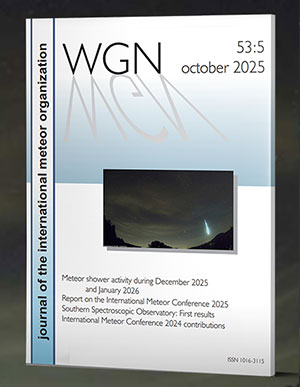September offers longer nights and cooler
temperatures in the northern hemisphere. In the sky, no major showers are visible
from either hemisphere but the northern hemisphere enjoys the advantage of higher
sporadic rates. The two recognized minor showers active in early September have
high northern declinations (celestial latitude) therefore are much better suited
to be viewed from locations north of the equator. Toward the end of the month the
antihelion radiant becomes entangled with the two Taurid radiants and it is
impossible to separate them. Therefore the antihelion radiant will be excluded
from the list from the last week of September until the end of the Taurid activity
period late in November. Observers in the southern hemisphere suffer from some of
their lowest rates of the year this month. The Taurid radiants are not too badly
placed so observers south of the equator can expect to see a little of this
activity toward the end of the month.
During this period the moon reaches its last quarter
phase on Monday September 22nd. At this time the moon will rise near 0100 local
daylight time (LDT) and will remain in the sky the remainder of the morning. As
the week progresses the waning crescent moon will rise later in the morning and
will become less of a nuisance. The estimated total
hourly rates for evening observers this week is near three for those located in
the mid-northern hemisphere (45 N) and one for those viewing from the mid-southern
hemisphere (45 S). For morning observers the estimated total hourly rates should
be near twelve for those located in the mid-northern hemisphere (45 N) and six
for those viewing from the mid-southern hemisphere (45 S). Locations between these
two extremes would see activity between the listed figures. These rates assume that
you are watching from rural areas away from all sources of light pollution. The
actual rates will also depend on factors such as personal light and motion perception,
local weather conditions, alertness and experience in watching meteor activity.
Rates are reduced during the morning hours due to moonlight.
The radiant positions and rates listed below are exact
for Saturday night/Sunday morning September 20/21. These positions do not change
greatly day to day so the listed coordinates may be used during this entire period.
Most star atlases (available at science stores and planetariums) will provide maps
with grid lines of the celestial coordinates so that you may find out exactly where
these positions are located in the sky. A planisphere or computer planetarium program
is also useful in showing the sky at any time of night on any date of the year.
Activity from each radiant is best seen when it is positioned highest in the sky,
either due north or south along the meridian, depending on your latitude. It must
be remembered that meteor activity is rarely seen at the radiant position. Rather
they shoot outwards from the radiant so it is best to center your field of view so
that the radiant lies at the edge and not the center. Viewing there will allow you to
easily trace the path of each meteor back to the radiant (if it is a shower member)
or in another direction if it is a sporadic. Meteor activity is not seen from radiants
that are located below the horizon. The positions below are listed in a west to east
manner in order of right ascension (celestial longitude). The positions listed first
are located further west therefore are accessible earlier in the night while those
listed further down the list rise later in the night.
The following showers are expected to be active this week:
The large Antihelion (ANT) radiant is now centered at 00:44 (011) +05.
This area of the sky lies in southern Pisces, two degrees south of the fourth
magnitude Delta Piscium. Actually, the radiant is so large that any meteor
from northeastern Aquarius, Pisces, southeastern Pegasus, or northern Cetus could be a
candidate for this shower. This radiant is best placed near 0200 LDT when it lies
on the meridian and is highest in the sky. Hourly rates at this time should be near
two no matter your location. With an entry velocity of 30 km/sec., the average
Antihelion meteor would be of medium-slow speed.
The Delta Aurigids (DAU) are present in the morning skies in the second half
of September and early October. Maximum activity occurs on October 3rd with an
average ZHR of two. Current rates will be most likely less than one per
hour. The radiant is currently located 04:48 (072) +48. This position lies in
northeastern Perseus, five degrees northwest of the zero magnitude star
Capella (Alpha Aurigae). At 64km/sec., the average Delta Aurigid is swift.
Sirko Molau’s study of video radiants has shown an active radiant located in Orion
during this period. The September Alpha Orionids (AOR) peak on September
27th with a radiant located near 05:24 (081) +07. The area of the sky is located
in northwestern Orion near the bright star Bellatrix (Gamma Orionis). Activity
is more than a ZHR of one between September 24th and the 30th. This radiant was
one of the strongest new showers detected in the video survey so visual detection
should be easy later in this period. Meteors from this radiant are not visible
during the evening hours as Orion lies beneath the horizon during this time. The
radiant gains altitude during the morning hours and is most favorably located near
0600 LDT when it lies highest above the horizon. Due to its location near the celestial
equator, activity is visible nearly everywhere. Tropical locations are favored as the
radiant passes overhead. Hourly rates this week would be less than one, increasing
next weekend. With an entry velocity of 59 km/sec., most members of the
September Alpha Orionids would possess a swift velocity.
As seen from the mid-northern hemisphere (45N) one would expect to see approximately
ten Sporadic meteors per hour during the last hour before dawn as seen from
rural observing sites. Evening rates would be near three per hour. As seen from the
mid-southern hemisphere (45S), morning rates would be near three per hour as seen
from rural observing sites and one per hour during the evening hours. Locations
between these two extremes would see activity between the listed figures. Moonlight
reduces rates during the morning hours this week from all locations.
The table below presents a summary of the expected activity this week. Rates and
positions are exact for Saturday night/Sunday morning but may be used all week.
| SHOWER | DATE OF MAXIMUM ACTIVITY | CELESTIAL POSITION | ENTRY VELOCITY | CULMINATION | HOURLY RATE | CLASS* | RA (RA in Deg.) DEC | Km/Sec | Local Daylight Time | North-South | Antihelion (ANT) | – | 23:20 (350) -03 | 30 | 02:00 | 2 – 2 | II | Delta Aurigids (DAU) | Oct 03 | 19:28 (292) +65 | 64 | 22:00 | <1 - <1 | II | September Alpha Orionids (AOR) | Sep 27 | 23:20 (350) -03 | 59 | 02:00 | <1 – <1 | IV |




 You saw something bright and fast? Like a huge shooting star? Report it: it may be a fireball.
You saw something bright and fast? Like a huge shooting star? Report it: it may be a fireball.  You counted meteors last night? Share your results with us!
You counted meteors last night? Share your results with us!  You took a photo of a meteor or fireball? You have a screenshot of your cam? Share it with us!
You took a photo of a meteor or fireball? You have a screenshot of your cam? Share it with us!  You caught a meteor or fireball on video? Share your video with us!
You caught a meteor or fireball on video? Share your video with us!